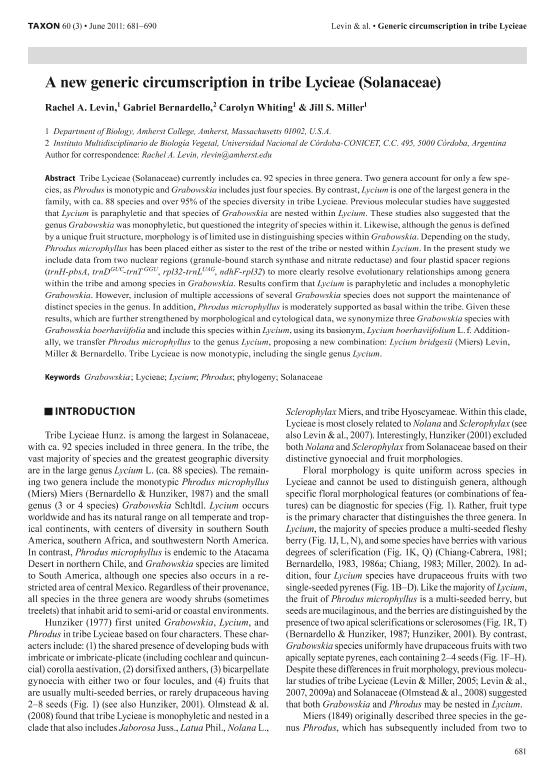Mostrar el registro sencillo del ítem
dc.contributor.author
Levin, Rachel
dc.contributor.author
Bernardello, Gabriel Luis Mario

dc.contributor.author
Whiting, Carolyn
dc.contributor.author
Miller, Jill
dc.date.available
2017-02-21T16:14:30Z
dc.date.issued
2011-06
dc.identifier.citation
Levin, Rachel; Bernardello, Gabriel Luis Mario; Whiting, Carolyn; Miller, Jill; A new generic circumscription in tribe Lycieae (Solanaceae); International Association For Plant Taxonomy; Taxon; 60; 3; 6-2011; 681-690
dc.identifier.issn
0040-0262
dc.identifier.uri
http://hdl.handle.net/11336/13251
dc.description.abstract
Tribe Lycieae (Solanaceae) currently includes ca. 92 species in three genera. Two genera account for only a few species, as Phrodus is monotypic and Grabowskia includes just four species. By contrast, Lycium is one of the largest genera in the family, with ca. 88 species and over 95% of the species diversity in tribe Lycieae. Previous molecular studies have suggested that Lycium is paraphyletic and that species of Grabowskia are nested within Lycium. These studies also suggested that the genus Grabowskia was monophyletic, but questioned the integrity of species within it. Likewise, although the genus is defined by a unique fruit structure, morphology is of limited use in distinguishing species within Grabowskia. Depending on the study, Phrodus microphyllus has been placed either as sister to the rest of the tribe or nested within Lycium. In the present study we include data from two nuclear regions (granule-bound starch synthase and nitrate reductase) and four plastid spacer regions (trnH-pbsA, trnDGUC-trnT GGU, rpl32-trnLUAG, ndhF-rpl32) to more clearly resolve evolutionary relationships among genera within the tribe and among species in Grabowskia. Results confirm that Lycium is paraphyletic and includes a monophyletic Grabowskia. However, inclusion of multiple accessions of several Grabowskia species does not support the maintenance of distinct species in the genus. In addition, Phrodus microphyllus is moderately supported as basal within the tribe. Given these results, which are further strengthened by morphological and cytological data, we synonymize three Grabowskia species with Grabowskia boerhaviifolia and include this species within Lycium, using its basionym, Lycium boerhaviifolium L.f. Additionally, we transfer Phrodus microphyllus to the genus Lycium, proposing a new combination: Lycium bridgesii (Miers) Levin, Miller & Bernardello. Tribe Lycieae is now monotypic, including the single genus Lycium.
dc.format
application/pdf
dc.language.iso
eng
dc.publisher
International Association For Plant Taxonomy

dc.rights
info:eu-repo/semantics/openAccess
dc.rights.uri
https://creativecommons.org/licenses/by-nc-sa/2.5/ar/
dc.subject
Lycium, Grabowskia, Phrodus
dc.subject
Sistemática
dc.subject
Solanaceae
dc.subject
Reordenamiento Taxonomico
dc.subject.classification
Ciencias de las Plantas, Botánica

dc.subject.classification
Ciencias Biológicas

dc.subject.classification
CIENCIAS NATURALES Y EXACTAS

dc.title
A new generic circumscription in tribe Lycieae (Solanaceae)
dc.type
info:eu-repo/semantics/article
dc.type
info:ar-repo/semantics/artículo
dc.type
info:eu-repo/semantics/publishedVersion
dc.date.updated
2017-02-14T14:34:44Z
dc.identifier.eissn
1996-8175
dc.journal.volume
60
dc.journal.number
3
dc.journal.pagination
681-690
dc.journal.pais
Austria

dc.journal.ciudad
Viena
dc.description.fil
Fil: Levin, Rachel. Amherst College. Department of Biology; Estados Unidos
dc.description.fil
Fil: Bernardello, Gabriel Luis Mario. Consejo Nacional de Investigaciones Científicas y Técnicas. Centro Científico Tecnológico Córdoba. Instituto Multidisciplinario de Biología Vegetal (p); Argentina
dc.description.fil
Fil: Whiting, Carolyn. Amherst College. Department of Biology; Argentina
dc.description.fil
Fil: Miller, Jill. Amherst College. Department of Biology; Estados Unidos
dc.journal.title
Taxon

dc.relation.alternativeid
info:eu-repo/semantics/altIdentifier/url/https://www.amherst.edu/media/view/331219/original/Levin%2Bet%2Bal.%2B2011%2BTaxon.pdf
Archivos asociados
